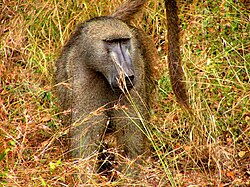

Portal maintenance status: (February 2020)
|
The Primates Portal Aprimate is a member of the biological order Primates, the group that contains lemurs, the aye-aye, lorisids, galagos, tarsiers, monkeys, and apes, with the last category including great apes. With the exception of humans, who inhabit every continent on Earth, most primates live in tropical or subtropical regions of the Americas, Africa and Asia. Primates range in size from the 30-gram (1 oz) pygmy mouse lemur to the 200-kilogram (440 lb) mountain gorilla. According to fossil evidence, the primitive ancestors of primates may have existed in the late Cretaceous period around 65 mya (million years ago), and the oldest known primate is the Late Paleocene Plesiadapis, c. 55–58 mya. Molecular clock studies suggest that the primate branch may be even older, originating in the mid-Cretaceous period around 85 mya. Primates exhibit a wide range of characteristics. Some primates do not live primarily in trees, but all species possess adaptations for climbing trees. Locomotion techniques used include leaping from tree to tree, walking on two or four limbs, knuckle-walking, and swinging between branches of trees (known as brachiation). Primates are characterized by their large brains relative to other mammals. These features are most significant in monkeys and apes, and noticeably less so in lorises and lemurs. Many species are sexually dimorphic, which means males and females have different physical traits, including body mass, canine tooth size, and coloration.
Show new selections below (purge) Selected articleGiant mouse lemurs are about three times larger than mouse lemurs, weighing approximately 300 g (11 oz), and have a long, bushy tail. They are most closely related to mouse lemurs within Cheirogaleidae, a family of small, nocturnal lemurs. Giant mouse lemurs sleep in nests during the day and forage alone at night for fruit, tree gum, insects, and small vertebrates. Home ranges often overlap, with related females living closely together while males disperse. Giant mouse lemurs are vocal, although they also scent mark using saliva, urine, and secretions from the anogenital scent gland. Predators of giant mouse lemurs include the Madagascar buzzard, Madagascar owl, fossa, and the narrow-striped mongoose. Giant mouse lemurs reproduce once a year, with two offspring born after a 90-day gestation. Babies are initially left in the nest while the mother forages, but are later carried by mouth and parked in vegetation while she forages nearby. In captivity, giant mouse lemurs will breed year-round. Their lifespan in the wild is thought to be five to six years. Both species are listed as endangered due to habitat destruction and hunting.
Selected pictureThe white-fronted capuchin, Cebus albifrons, is a species of capuchin monkey, a type of New World primate, found in seven different countries in South America: Bolivia, Brazil, Colombia, Venezuela, Ecuador, Peru, and Trinidad and Tobago. The species is divided into several different subspecies, though the specific divisions are uncertain and controversial.
Categories
Select [►] to view subcategories Selected species
 Least Concern (IUCN 3.1)|Least Concern
The chacma baboon (Papio ursinus), also known as the Cape baboon, is from the Old World monkey family. It is one of the largest of all monkeys. Found primarily in southern Africa, the chacma baboon has a wide variety of social behaviors, including a dominance hierarchy, collective foraging, adoption of young by females, and friendship pairings. These behaviors form parts of a complex evolutionary ecology. In general the species is not threatened, but human population pressure has increased contact between humans and baboons. Hunting, accidents and trapping kill or remove many baboons from the wild. This has reduced baboon numbers and disrupted their social structure.
Did you know?
Primate listsWikiProjectsTopicsTarsier • Omomyidae • Monkey • Old World monkey • New World monkey • Ape Related portals
Things to do
Associated Wikimedia
Discover Wikipedia using portals
|